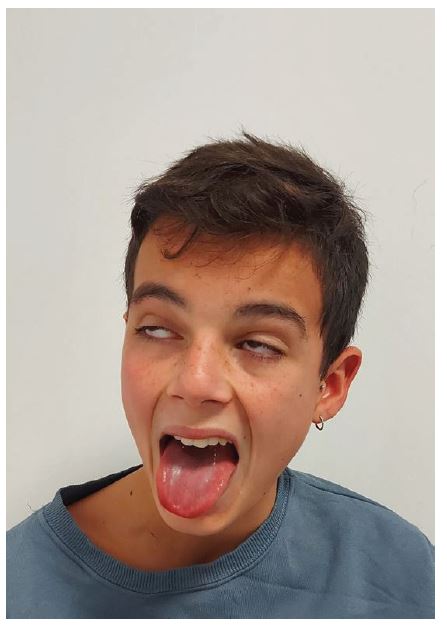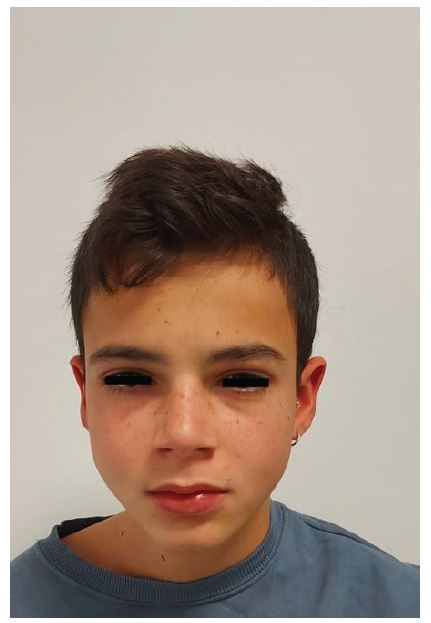Imaging cases
Involuntary movements in an adolescent
Movimentos involuntários num adolescente
1. Department of Pediatrics and Neonatology, Centro Hospitalar do Tâmega e Sousa. 4564-007 Guilhufe, Portugal. mafalda.moreira@campus.ul.pt; diana.alba.04@gmail.com; anainesrpf@gmail.com; claudia.monteiro@netcabo.pt
Abstract
Extrapyramidal symptoms (EPS), such as dystonia, akathisia, and parkinsonism, are movement disorders that have been described as a side effect of antipsychotic medications in adults. In children, their use has expanded, as have this type of symptoms, especially those caused by first-generation antipsychotics. Paliperidone is a second-generation drug approved for schizophrenia in adolescents. The authors describe the case of a 12-year-old boy with a chronic disruptive behavior disorder who was admitted to the Emergency Department with tongue protrusion, inability to speak, eye rolling, and body tremors since that day. He was treated with paliperidone, the dose of which had been doubled in the previous month. Examination revealed dystonia of the eyes, mouth, and tongue, and increased neck tone. Biperiden was administered with complete resolution of symptoms after five minutes, and paliperidone was discontinued. This case suggests that caution should be exercised when prescribing antipsychotics (even second-generation agents). As the use of antipsychotics in children is increasing, pediatricians should be familiar with the acute presentation of side effects of these drugs.
Keywords: adverse effect; antipsychotic; dystonia; extrapyramidal symptoms; paliperidone
Resumo
As síndromes extrapiramidais, como a distonia, a acatisia e o parkinsonismo, são doenças do movimento descritas como efeito adverso dos antipsicóticos em idade adulta. A sua utilização tem-se disseminado entre as crianças e, como tal, também este tipo de sintomas, principalmente associados aos fármacos de primeira geração. A paliperidona é um antipsicótico de segunda geração aprovado para o tratamento da esquizofrenia em adolescentes. É apresentado o caso de um adolescente de 12 anos do sexo masculino com transtorno disruptivo do comportamento admitido no Serviço de Urgência por protusão da língua, incapacidade de fala, reversão ocular e tremor involuntário desde o próprio dia. O rapaz estava cronicamente medicado com paliperidona, cuja dose tinha sido duplicada no mês anterior. Ao exame objetivo, apresentava distonia ocular e oromandibular e aumento do tónus cervical. Foi administrado biperideno, com total resolução da sintomatologia em cinco minutos. O tratamento com paliperidona foi descontinuado. Este caso demonstra que a prescrição de antipsicóticos, nomeadamente de segunda geração, deve ser criteriosa. Atendendo a que a sua utilização na infância tem aumentado, é importante que os pediatras estejam familiarizados com a apresentação clínica dos efeitos adversos associados a estes psicofármacos.
Palavras-chave: antipsicótico; distonia; efeito adverso; paliperidona; sintomas extrapiramidais
A 12-year-old male with a chronic disruptive behavior disorder presented to the Emergency Department with tongue protrusion, inability to speak, eye rolling, and involuntary body tremors manifesting on the same day. His mother reported that this was the fifth episode in the past month, all of which resolved spontaneously within a few hours. There was no history of fever, trauma, or ingestion of an unknown substance. The boy had been treated with paliperidone 3 mg daily for several years, but the dose had to be increased to 6 mg/day during the previous month.
Physical examination revealed eye, mouth, and tongue dystonia, and increased neck tone with left-sided deviation (Figure 1). No other abnormalities were found on neurologic examination. Vital signs were stable, and the Glasgow Coma Scale score was 15.
A 3-mg intravenous infusion of biperiden was administered with complete resolution of symptoms in five minutes (Figure 2).
What is your diagnosis?
Diagnosis
Paliperidone-induced extrapyramidal syndrome
Patient management
At the time of discharge, paliperidone was discontinued and the patient was advised to consult his psychiatrist for a change in therapy.
Discussion
Extrapyramidal symptoms (EPS) are movement disorders that can be caused by brain damage or induced by drugs.1) They include dystonia, akathisia, and parkinsonism, which occur within a few days of starting or increasing medication, or tardive dyskinesia, which is a late side effect.2,3
EPS are the most common side effect described in patients treated with antipsychotics, especially first-generation antipsychotics.1,3,4) Severe or fatal cases have been reported.1)
Paliperidone is an atypical or second-generation antipsychotic (SGA) approved for the treatment of schizophrenia in adolescents and also used off-label for behavioral disorders in children and adolescents.5 This type of antipsychotic exhibits antagonism to both dopamine D2 and serotonin type 2A receptors.2,3) Drug-induced extrapyramidal syndrome can be explained by the affinity of antipsychotics for D2 receptor blockade in the nigrostriatal tract, which interferes with normal dopamine and acetylcholine neurotransmission.6) Studies have shown that the risk of EPS is higher with typical antipsychotics, but several cases have been described in patients treated with SGA.2,4,6) This type of symptom is usually associated with high doses and can occur when an antipsychotic is initiated or when the dose is increased, regardless of previous treatment duration.3,5
As observed in this case, dystonia may present as spasmodic torticollis and tongue protrusion or as blepharospasm, trunk extension, and forced jaw opening.1-3)
Extrapyramidal side effects in children can be treated with anticholinergic medications such as benztropine, biperiden, or diphenhydramine.1-3 In some cases, an extended treatment period of two to five days should be considered to prevent recurrence of symptoms.3 The antipsychotic agent should be discontinued or, if antipsychotic treatment is required, the dose reduced.1-3
The number of mental disorders in children for whom treatment with SGA is recommended has increased in recent years.3) Despite their weak effect on D2 receptors, with an expected low liability for inducing EPS, recent studies show that the risk of side effects is higher than previously thought.2-4) Therefore, it is essential to use SGA cautiously in children and adolescents and to quantify the risk-benefit ratio.2,4 Parents should be informed about the possibility of extrapyramidal symptoms, and pediatricians should be familiar with the acute presentation of adverse effects of these drugs.2,4
Authorship
Mafalda Moreira - Conceptualization; Investigation; Project administration; Visualization; Writing - original draft; Writing - review & editing
Diana Alba - Validation; Writing - review & editing
Inês Paiva Ferreira - Validation; Writing - review & editing
Cláudia Monteiro - Investigation; Supervision; Validation; Writing - review & editing
References
1. Chang MY, Lin KL, Wang HS, Wu CT. Drug-Induced Extrapyramidal Symptoms at the Pediatric Emergency Department. Pediatr Emerg Care. 2020;36(10):468-72.
[ Links ]
2. Fatima S, Mottola N. Case 5: A 7-year-old Autistic Boy with Altered Movements and Mental Status. Pediatr Rev. 2017;38(10):493.
[ Links ]
3. Pringsheim T, Doja A, Belanger S, Patten S; Canadian Alliance for Monitoring Effectiveness and Safety of Antipsychotics in Children (CAMESA) guideline group. Treatment recommendations for extrapyramidal side effects associated with second-4. generation antipsychotic use in children and youth. Paediatr Child Health. 2011;16(9):590-8.
[ Links ]
5. Elahi E, Zia U, Bhutta OA, Andleeb S. Extrapyramidal symptoms resulting from risperidone use in a four-year-old child: A case report. J Pak Med Assoc. 2018;68(11):1719-20.
[ Links ]
6. Stahl, SM. (2014) Sthal's essential psychopharmacology: Prescriber's guide. 5th ed. Cambridge University Press.
[ Links ]
7. Sathpathy S, Winsberg B. Extrapyramidal Symptoms in Children on Atypical Antipsychotic Drugs. Journal of Clinical Psychopharmacology. 2003; 23(6):675-7.
[ Links ]

















